'Everything hurt': Survivors share horror, heartbreak of Goodyear bike crash that killed 2, hurt 19
Feb. 25 last year dawned cool and clear with a gentle breeze, the perfect day for members of the West Valley Cycle Group meeting up at the Santini Bicycling Outlet for their normal Saturday bike ride.
But the ride in Goodyear ended unlike any other, in horror and heartbreak.
Memories of it were etched on the minds of those who rode, people like Ethan Boch, who recalled hearing noises he didn't recognize. Sickening noises like gunfire. And crunching.
Others recall the images: Bikes mangled beyond recognition. People dragged hundreds of yards. Broken bodies and paramedics handing out triage cards.
When it was all over, 19 bicyclists were injured, some badly. Two were dead.
What happened has now been detailed in interviews that witnesses like Boch gave to National Transportation Safety Board investigators, who recently released their report on the crash.
Boch, a field sales representative born and raised in the Phoenix area, had been biking 15 years, 13 with West Valley Cycle. And although he’d seen bike crashes before, the one that day was unlike any other, he told NTSB.
A white 2019 Ford F-250 pickup, driven by 26-year-old Pedro Quintana-Lujan, crashed into the group of cyclists on South Cotton Lane Bridge. More than a year later, some victims are still dealing with the aftermath of their injuries.
Quintana-Lujan was arrested and released. He was charged with misdemeanors in local court for his role in the crash that galvanized the bicycling community.
A group of friends sets out
Boch rode with the club almost every Saturday. He lives in Scottsdale and drove to Goodyear to meet up with the group at Santini.
Arthur Grijalva, who has been cycling with the group for about four years and started cycling nearly 30 years ago, was previously a part of a dwindling bike club. He searched for new bike groups and came across West Valley Cycle.
The first weekend he came, he was surprised that the club had 80 to 90 riders. He started biking with the group every weekend.
"You see the same people every week and you develop friendships," Grijalva told NTSB investigators. "I came to be friends with three or four. We always rode together and had coffee afterwards."
Steven Rhone moved to Arizona 20 years ago from Oakland, California to finish his career as an electrician. He had been riding and racing since his early 20s. Rhone had retired months before that morning's fateful ride.
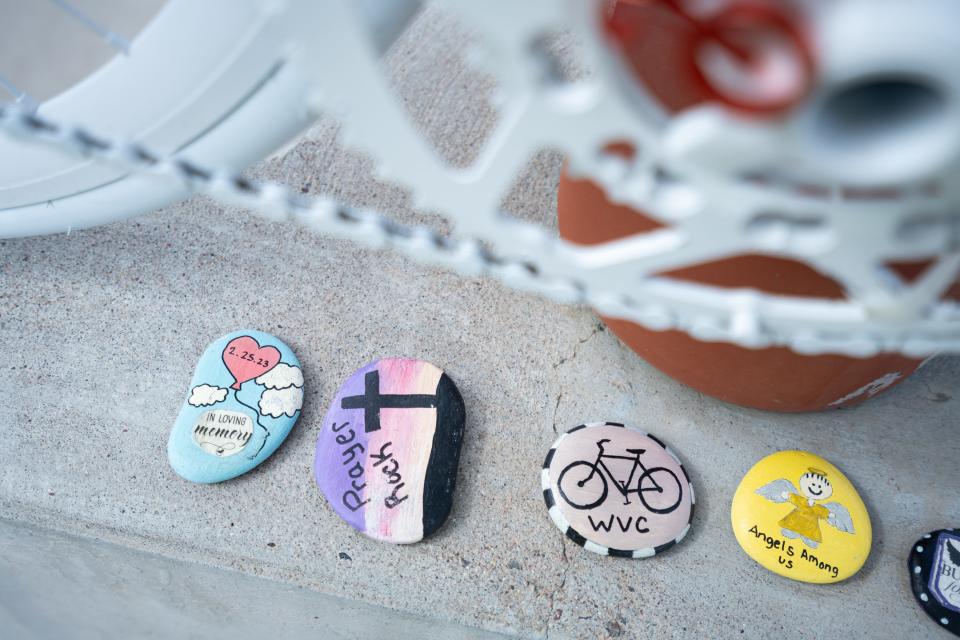
He remembered the bike club for its "camaraderie, friendship and laughter," and noted the group was so closed-knit, members would dine, party and go on vacations together.
George Brennock, who was visiting from the Cincinnati area, was biking with the same group. He remembers wearing a heavy, bright yellow long-sleeved jersey.
He was renting a bike and had purchased a mirror to put on the left handlebar, allowing him to see what was going on behind him and to the side.
The group departed the bike shop at around 7:30 a.m., said Alfred Gonzales, an Air Force veteran who lives in Surprise and has been riding with West Valley Cycle for about 12 years.
The traffic was typical, and the weather was nice that morning, Gonzales said.
It was partly cloudy with a gentle breeze, no rain, in the mid-50s at the start of the ride, with highs reaching the 70s.
Although he was concerned about being able to keep up with the C group, Brennock found himself in the B group, which is the second-fastest group behind the A group.
The moment of impact: A boom, crunching sounds and pop, pop, pop
The group reached South Cotton Lane Bridge, with Brennock toward the end of the B group. At that point, the area was becoming more rural, Brennock said.
“I’m not looking in my sideview mirror. You know, I'm making the assumption that if I'm in a bike lane, then I'm safe,” Brennock said.
“And all of a sudden I am dumbfounded how close — and I mean really, really close — a truck passes me,” Brennock said.
The truck was moving from left to right, hitting the person biking in front of Brennock, and then sending that person crashing into the person in front of them.
Boch was leading the B group along what he described as one of the widest stretches of the 65-mile MC-85. He was unaware what was going on behind him.
That's when he heard the sound he’ll never forget, the one he had never heard before.
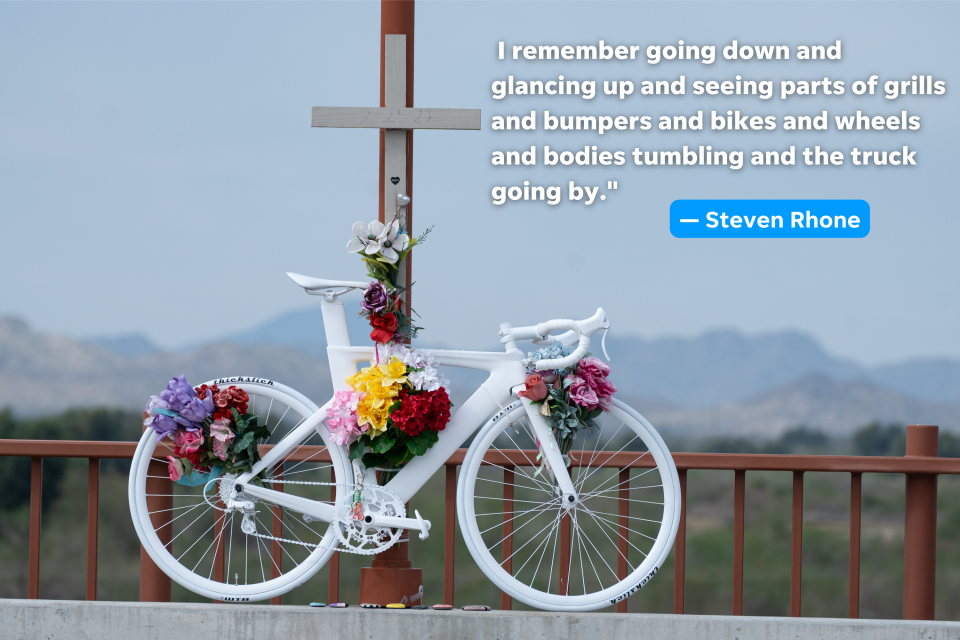
"I’ve been cycling long enough that I've heard bike crashes where, you know, six or even 10 people get tangled up and fall down and it's a particular sound," he said.
"But this was a completely different sound than that. Just, you know, like a boom and a crunching sound, and then you could hear the bicycle tires popping, which almost sound like a, you know, a small caliber gunshot. It was just a pop, pop, pop, pop," Boch said.
"You're riding along, and your brain can't process what's happening because there are sounds that you've never heard before."
Before he knew it, riders from behind and to the side pushed him off the bike.
As he went down, he saw the truck run over cyclist Karen Malisa and drag her several hundred yards.
The truck continued to move further into the bike lane, running people over, Brennock said. It continued to drag people for about a quarter of a mile, he said. And because there was a wall to the side of the bike lane, the cyclists had no way to escape the accident.
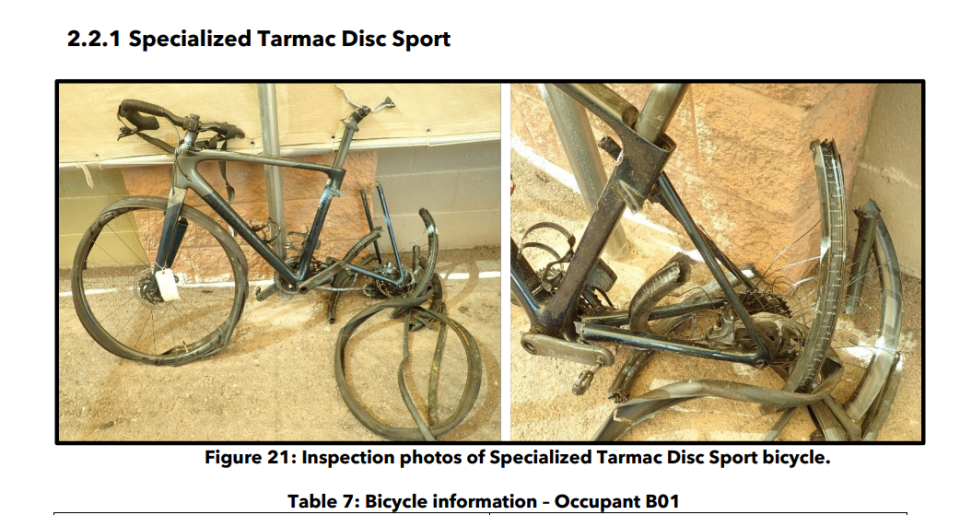
Steven Rhone was in the B group. He knew there was a problem because he recognized the unique sound made by carbon fiber bikes.
"When they crash, they make a unique, almost a mini-explosion sound, with the carbon fiber breaking and snapping. I heard that," he said, demonstrating by clapping his hands. "But the unusual part ... it kept getting louder and louder."
He said the noise just got louder and closer and wasn't stopping. It was constant.
"And then the next thing I know, in the next instant, I was on the ground," Rhone recalled. "I was not hit by the truck. I was hit by debris and bodies that were being shoved into me from behind and the side. I remember going down and glancing up and seeing parts of grills and bumpers and bikes and wheels and bodies tumbling and the truck going by."
Gonzales, who was toward the back of the pack of bikes, said he didn’t hear anything out of the ordinary. Next thing he knew, he was lying on the ground.
He observed someone else trying to stand up before giving up and falling on the ground. Gonzales then realized that he couldn’t stand up. He began to feel pain and noticed he was having difficulty breathing.
"I had no idea what happened. All I know was that I was in significant pain," Gonzales said.
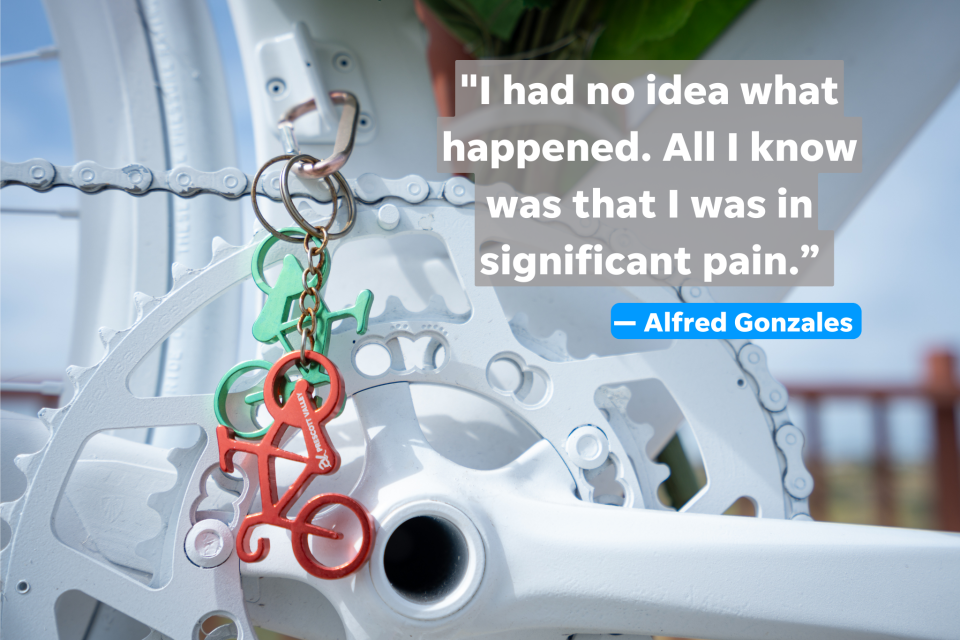
A grisly medical emergency scene like a war zone
After getting up, Boch was surrounded by remnants of unrecognizable bikes and at least a dozen cyclists on the ground.
Fellow cyclist Leo DeMarco immediately discovered that Malisa had no pulse.
61-year-old Malisa was later identified as one of two people killed in the crash, along with David Kero, 65.
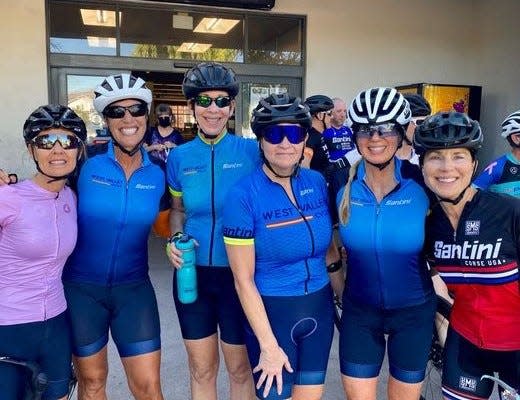
Boch then saw Quintana-Lujan, the truck driver, approach the group. They had a confrontation and Quintana-Lujan soon got back into his cab.
In the midst of the chaos, Boch managed to call for emergency personnel, with police and fire personnel arriving on the scene within two to three minutes.
"I was amazed with it because I’ve never been in a type of mass casualty situation like that. One of the thoughts that was going through my head was let’s see what my friends that were over in Iraq and Afghanistan had to deal with," Boch said.
"They immediately had triage cards. And they were just going around and doing super-quick triage assessments on everybody and then assigning them a number," he said.
Witnesses reported the first help arrived within four minutes.
But for Alfred Gonzelez, time stopped. For him, it felt like forever.
"I remember thinking that I just maybe I just want to die now, because everything hurt so bad. And, so the guy said, 'No, no, no, you've got to stay with me, stay with me, they're coming, they're coming. They're getting close,'" he said.
Eric Kleinschmidt, battalion chief of the Goodyear Fire Department, said in an interview with the NTSB that the agency first got a call for 10 people who needed immediate medical attention, and eight people who needed delayed medical attention. Those numbers then changed to eight and seven, respectively.
When he arrived at the scene, Kleinschmidt saw first responders performing CPR on one of the victims. Several agencies showed up to the scene after it was increased from a first alarm to a second alarm accident, including Battalions from both Avondale and Buckeye.
The most challenging part was getting the needed number of ambulances in the needed amount of time, Kleinschmidt said.
There was also a need for more ambulances, which operate within the city as a private entity. While the Goodyear Fire Department began its own ambulance program in March, the accident took place several weeks shy of the program going live.
And although there was light traffic, some cars stopped to help, Brennock said. Because Brennock was uninjured, he stayed with one of the cyclists in front of him until emergency personnel arrived.
Gonzales remembers hearing sirens. After paramedics arrived, he saw a red tag, which meant he was one of the victims who was tagged as needing immediate medical attention. He was then transported to a hospital.
The recovery: He couldn't open a bottle of Gatorade himself
Grijalva’s first memory was in the evening in the emergency room.
“I actually have no recollection of that morning. I do not remember waking up. I don't remember putting my bike on my car, driving to the start, getting ready, riding with the group in the beginning,” Grijalva said.
Grijalva ended up having severe bleeding in his brain. He had a seizure as soon as he woke up but credits the helmet with helping limit the severity of the injury. He also had a collapsed lung, bruised pancreas, broken ribs, a dislocated hip and fractures in his neck and spine.
Grijalva then went to live in a skilled nursing facility and, after two months, found himself back in the emergency room after he developed a buildup of blood around the lungs.
He got surgery to fix the wound that was causing blood to go into his chest and went back to the skilled nursing facility for several weeks. Grijalva went home in May before starting physical therapy.
“I'm just amazed at how much strength you lose when you're bedridden for three months,” Grijalva said, adding that he couldn’t even open a Gatorade bottle himself.
Gonzales sustained several injuries, including 15 broken ribs and a punctured lung, and microfractures on his spine, among others.
The investigation: The cause of the crash is still a mystery
“It's very unfortunate, very sad event, but I think we had a great response,” Kleinschmidt said in the interview.
After making sure everyone who needed immediate medical attention had been transported to the hospital, Kleinschmidt said his focus shifted to the investigation, which consisted of interviewing people at the scene and then getting them back to their families.
But, despite several hundred pages of detailed documentation, the NTSB never determined the cause of the crash.
The statements of the truck driver, Quintana-Lujan do not match some of the forensic evidence or eyewitness accounts of the West Valley Cycle Group.
Quintana-Lujan told police at the time that his steering wheel was locked, investigations have found there was nothing wrong with his steering wheel.
Quintana-Lujan was later determined to not be intoxicated at the time of the crash, although he did have a small amount of THC in his system, which is associated with cannabis use. Quintana-Lujan told investigators he had used cannabis the night prior to the crash.
According to the NTSB report, Quintana-Lujan stated that he stayed in the left lane and continued south to the Cotton Lane Bridge. He was driving on the bridge at 45 mph when the steering wheel “got hard.” He told authorities he had both hands on the steering wheel and couldn’t overcome the force to steer it back.
Then he heard scratching noises and let go of the gas pedal, which allowed him to regain control of the vehicle. He said he turned the wheel to the left and stopped the pickup, the NTSB reported.
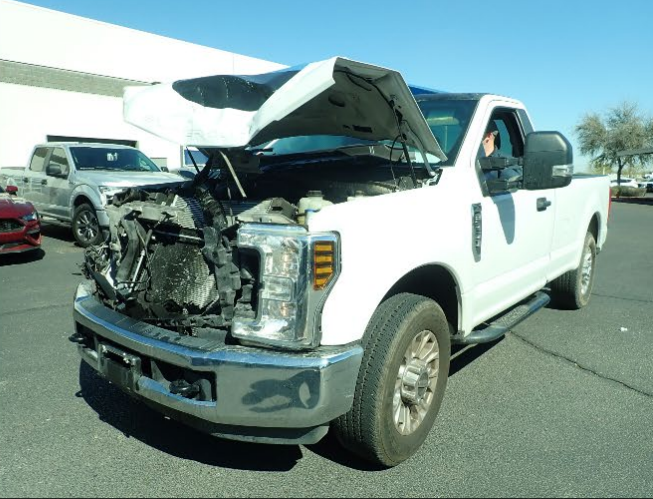
But Brennock, who did not get hit, said his first reaction was that the crash may have been a deliberate act since the truck did not immediately stop and continued moving left to right.
Other accounts back that up.
"I did not see any brake lights on the truck, it looked like 6 he didn't tap his brakes at all, not even tapping them, he just plowed right through them,' one of the bicyclists Robert Hintsala told the NTSB team.
"To me, it was almost like he was still accelerating. From where he made the initial impact to where he actually physically stopped was a great distance. And it wasn’t like he was on his brakes or anything. I didn’t see brake lights until he physically stopped towards the end of the bridge," Rhone said.
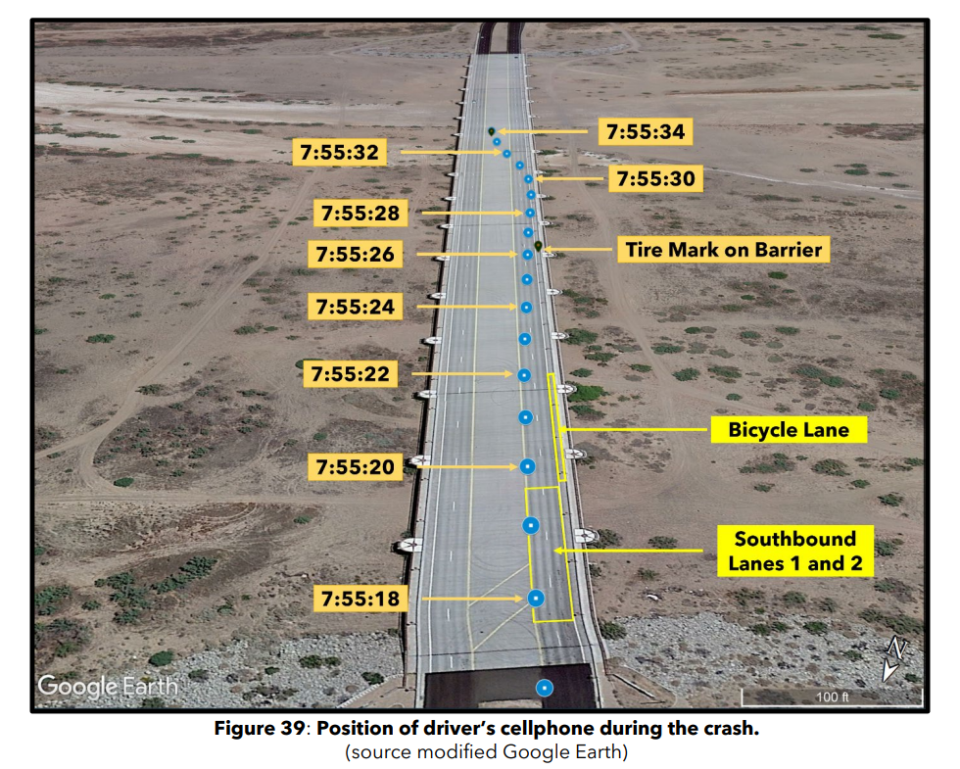
The testimony is consistent with a diagram in the NTSB report. Comparing time stamps, GPS data from Quintana-Lujan's phone and physical evidence from the crash scene, investigators concluded that he was driving 70 mph as he took the curve leading onto the bridge.
He was going between 55 and 60 mph as he neared the bridge, where he veered into the bike lane and where inspectors found a tire mark on the wall next to it. The time stamps end eight seconds later with the truck going 50 mph in the middle lane.
The posted speed limit is 45 mph.
Officers initially booked Quintana-Lujan into jail on two counts of manslaughter, three counts of aggravated assault, 18 counts of endangerment and two counts of causing serious injury or death by a moving violation. He was held on a $250,000 bond.
He told police, according to the booking sheet, that he had been driving 40 to 50 mph. Police said they found no signs of evasive action such as tire or skid marks. They calculated the F-250 traveled 520 feet from the place it struck the concrete side wall to where it finally stopped. Police said in court documents they found shreds of clothing lodged in the truck's axle.
But Maricopa County Attorney Rachel Mitchell referred the case back to the Goodyear Police Department, stating it needed more time to complete its investigation. Quintana-Lujan was released from jail.
Mitchell announced that the case would be referred back to the city as there wasn't enough evidence to pursue a felony conviction.
Goodyear police detectives then referred charges to the Goodyear City Prosecutor’s Office.
Days after the anniversary, the Goodyear city prosecutor charged Quintana-Lujan with 11 misdemeanor counts of causing serious physical injury or death by a moving violation.
Some members of West Valley Cycle expressed disappointment over Quintana-Lujan effectively avoiding felony charges.
Malisa's husband of 35 years, Steve Malisa, described the decision as blindsiding.
"The person who's supposed to defend the people, the county, I think let us all down because she doesn't think she can win it. Didn't even want to try. That's the thing that bothers us the most," Malisa previously told The Arizona Republic.
These days, West Valley Cycle remains closer than ever. Nearly 240 people showed up for a memorial ride on Feb. 25, the anniversary of the crash.
"When people who don’t know the group, they just think this is: guys get together that go out and ride. No, it’s all walks of life. Male, female. All religions. All political aspects. So, you know, we sit down and we have good conversations. We laugh, we cry together," Rhone said.
Reach the reporter at ahardle@gannett.com or by phone at 480-259-8545. Follow her on X, formerly Twitter: @AlexandraHardle.
This article originally appeared on Arizona Republic: Goodyear bike crash victims recall accident that killed 2, injured 19

